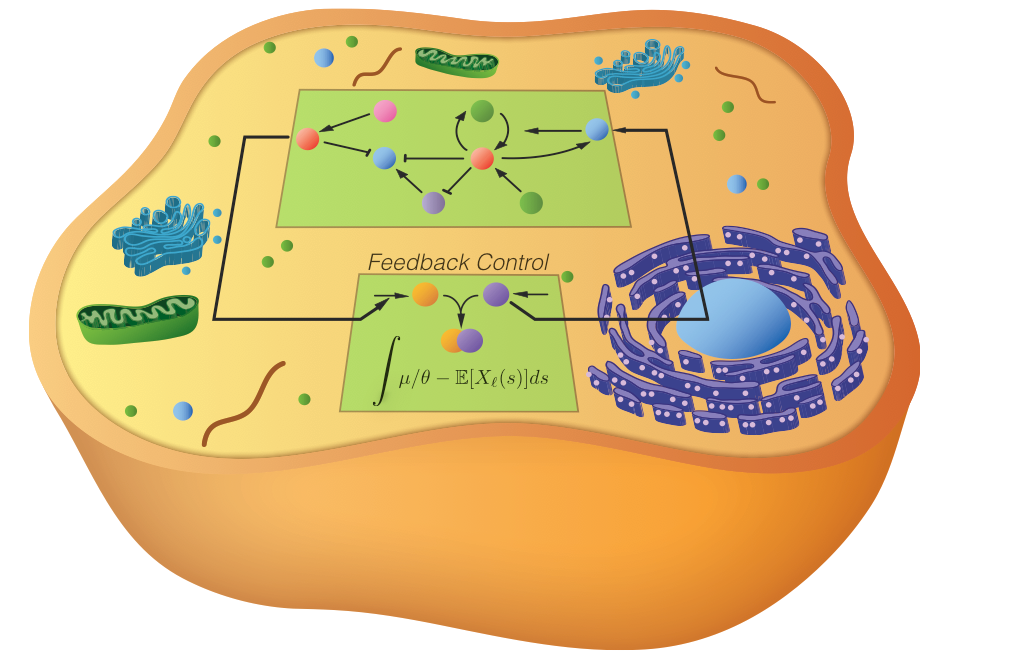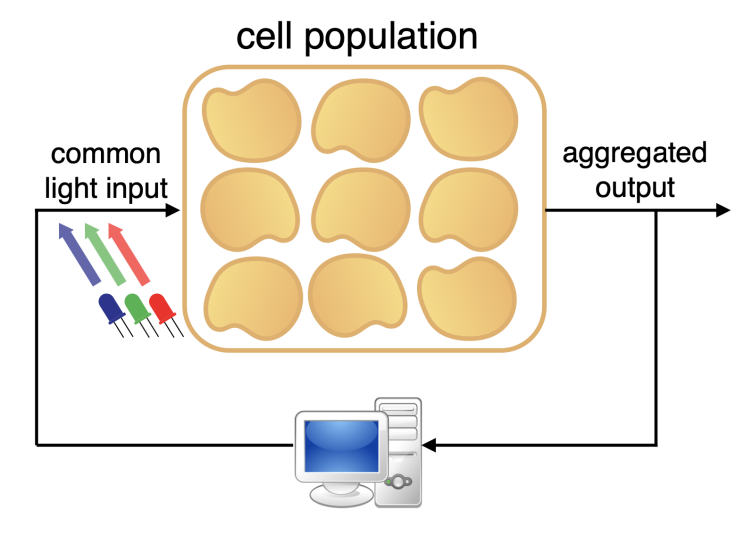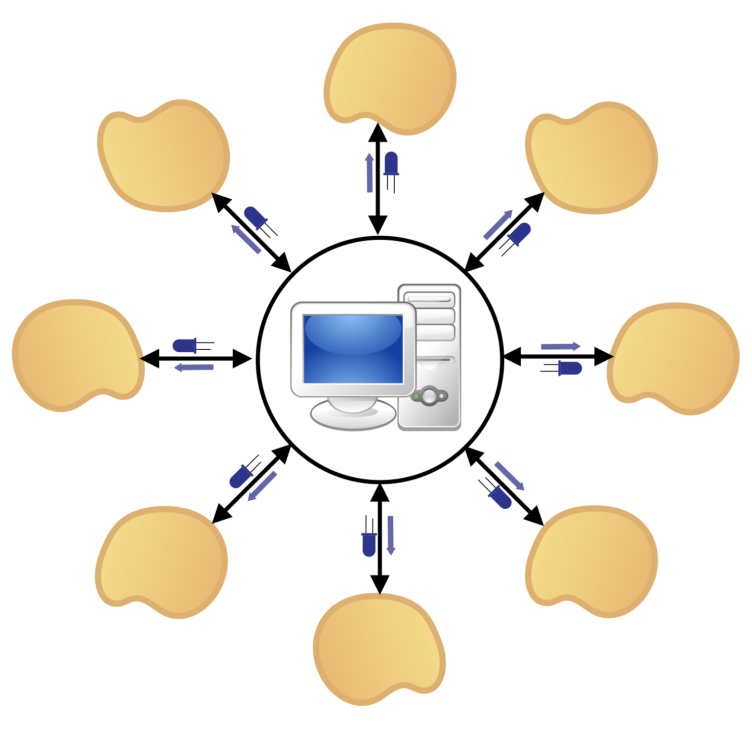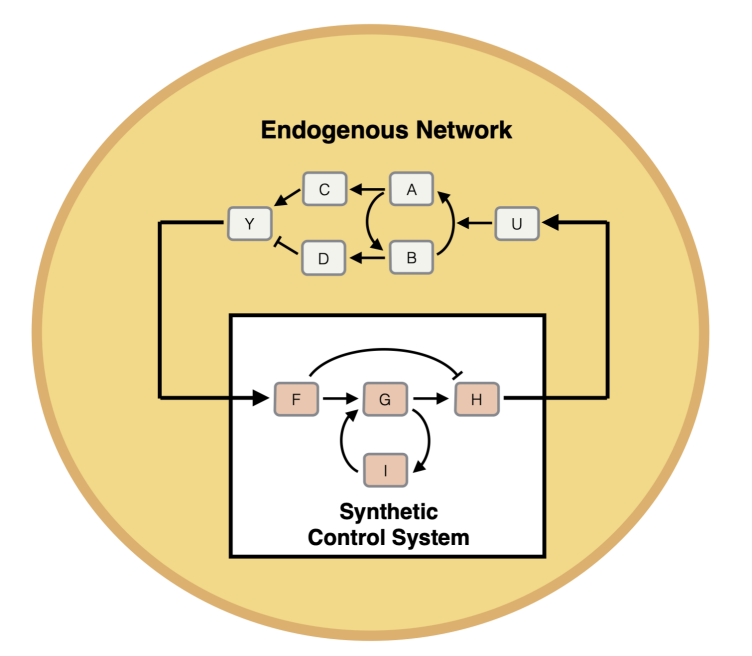Cybergenetics: The new field of control systems for living cells

In his 1948 book, Cybernetics, Norbert Wiener presented a vision where the study of control and communication in the animal and the machine are unified. The field of Cybernetics (art of steering) was born. Predating the discovery of the structure of DNA and the ensuing molecular biology revolution, cybernetic applications in the life sciences at the time were limited. More than 60 years later, the confluence of modern genetic manipulation techniques, powerful measurement technologies, and advanced analysis methods is enabling a new area of research in which systems, communications, and control theory notions are used for synthetically regulating cellular processes at the gene level. We refer to the resulting field of research at the interface between cybernetics and genetics with the portmanteau Cybergenetics.
We are developing novel analytical and experimental methods for the analysis and design of cybergenetic systems. Our current work demonstrates how de novo control systems can be interfaced with living cells and used to control their dynamic behavior in real time.
Computer Control of Cell Populations

Here we use a computer to dynamically control populations of living cells using light in a negative feedback vashion. Populations thus controlled robustly and precisely regulate a variable of interest (e.g. an enzyme) to follow a desired profile. We are pursing applications in industrial biotechnology.
More on computer control of cell populations
Computer Control of Single Cells

Here we use a computer to dynamically control populations of living cells using light in a negative feedback vashion. Populations thus controlled robustly and precisely regulate a variable of interest (e.g. an enzyme) to follow a desired profile. We are pursing applications in industrial biotechnology.
More on computer control of single cells
Genetically Engineered Control Systems

Here the control system is engineered into the living cell and is implemented entirely with biomolecular components. Sensing, actuation, and computation take place within each cell using biomolecular reactions of cellular species. We are motivated by applications in basic science, medical therapy, and industrial biotechnology.
More on genetically engineered control systems
Melinda Liu Perkins, Dirk Benzinger, Murat Arcak and Mustafa Khammash. "Cell-in-the-loop pattern formation with optogenetically emulated cell-to-cell signaling," Nature Communications, vol. 11: no. 1, pp. 1355, London: Nature Publishing Group, 2020.
external page DOI: 10.1038/s41467-020-15166-3
Stephanie K. Aoki, Gabriele Lillacci, Ankit Gupta, Armin Baumschlager, David Schweingruber & Mustafa Khammash. "A universal biomolecular integral feedback controller for robust perfect adaptation," Nature. 19 June 2019. external page doi.org/10.1038/s41586-019-1321-1
Gabriele Lillacci, Yaakov Benenson and Mustafa Khammash. "Synthetic control systems for high performance gene expression in mammalian cells," Nucleic Acids Research, vol. 46: no. 18, pp. 9855-9863, Oxford: Oxford University Press (OUP), 2018.
external page DOI: 10.1093/nar/gky795
Dirk Benzinger, Marc Rullan, Andreas Milias-Argeitis and Mustafa Khammash. "Studying and Regulating Transcription Using Single-Cell Optogenetics: Principles of Systems Biology," No. 30. Cell Systems, vol. 7: no. 1, pp. 1-1, Cambridge: Cell Press, 2018. external page Article
Marc Rullan, Dirk Benzinger, Gregor W. Schmidt, Andreas Milias-Argeitis, Mustafa Khammash. "An Optogenetic Platform for Real-Time, Single-Cell Interrogation of Stochastic Transcriptional Regulation," Molecular Cell, 2018. external page Article
Corentin Briat, Ankit Gupta and Mustafa Hani Khammash. "Antithetic proportional-integral feedback for reduced variance and improved control performance of stochastic reaction networks," Journal of the Royal Society. Interface, 15 (143): 20180079, London: The Royal Society, 2018. external page doi:10.1098/rsif.2018.0079
Corentin Briat and Mustafa Khammash. "Perfect Adaptation and Optimal Equilibrium Productivity in a Simple Microbial Biofuel Metabolic Pathway Using Dynamic Integral Control," ACS Synthetic Biology, 7 (2): 419-431, Washington, DC: American Chemical Society, 2018. external page doi:10.1021/acssynbio.7b00188
Dirk Benzinger and Mustafa Khammash. "Pulsatile inputs achieve tunable attenuation of gene expression variability and graded multi-gene regulation," Nature Communications, vol. 9, pp. 3521, London: Nature Publishing Group, 2018.external page DOI: 10.1038/s41467-018-05882-2
Armin Baumschlager, Stephanie K. Aoki and Mustafa Khammash. "Dynamic Blue Light-Inducible T7 RNA Polymerases (Opto-T7RNAPs) for Precise Spatiotemporal Gene Expression Control," ACS Synthetic Biology, 6 (11): 2157-2167, London: American Chemical Society, 2017. external page doi:10.1021/acssynbio.7b00169
C. Briat, C. Zechner, and M. Khammash. "Design of a Synthetic Integral Feedback Circuit: Dynamic Analysis and DNA Implementation," ACS Synthetic Bioliogy, 2016. external page doi:10.1021/acssynbio.6b00014
C. Zechner, G. Seelig, M. Rullan, and M. Khammash. "Molecular circuits for dynamic noise filtering," Proceedings of the National Academy of Sciences of the United States of America, 2016. external page doi:10.1073/pnas.1517109113
C. Briat, A. Gupta, and M. Khammash. "Antithetic Integral Feedback Ensures Robust Perfect Adaptation in Noisy Bimolecular Networks," Cell Systems, 2016. external page doi:http://dx.doi.org/10.1016/j.cels.2016.01.004
A. Milias-Argeitis, M. Rullan, S. Aoki, P. Buchmann, and M. Khammash. "Automated optogenetic feedback control for precise and robust regulation of gene expression and cell growth," Nature Communications, 2016. external page doi:10.1038/ncomms12546
Andreas Milias-Argeitis, Stefan Engblom, Pavol Bauer and Mustafa Khammash. "Stochastic focusing coupled with negative feedback enables robust regulation in biochemical reaction networks," Interface: Journal of the Royal Society, vol. 12: no. 113, pp. 20150831, London: Royal Society, 2015. external page DOI: 10.1098/rsif.2015.0831
J. Ruess, F. Parise, A. Milias-Argeitis, M. Khammash, and J. Lygeros. "Iterative experiment design guides the characterization of a light-inducible gene expression circuit," Proceedings of the National Academy of Sciences, 2015. external page doi:10.1073/pnas.1423947112
A. Gupta, C. Briat, and M. Khammash, "A Scalable Computational Framework for Establishing Long-Term Behavior of Stochastic Reaction Networks," PLoS Computational Biology, 2014. external page doi:http://dx.doi.org/10.1371/journal.pcbi.1003669
C. Briat and M. Khammash, "Integral population control of a quadratic dimerization process," IEEE Conference on Decision and Control, 2013, pp. 3367-3372. external page doi:10.1109/CDC.2013.6760398
C. Briat and M. Khammash, "Computer control of gene expression: Robust setpoint tracking of protein mean and variance using integral feedback," IEEE Conference on Decision and Control, 2012, pp. 3582-3588. external page doi:10.1109/CDC.2012.6426720
A. Milias-Argeitis, S. Summers, J. Stewart-Ornstein, I. Zuleta, D. Pincus, H. El-Samad, M. Khammash, and J. Lygeros. "In silico feedback for in vivo regulation of a gene expression circuit," Nature Biotechnology, 2011. external page doi:10.1038/nbt.2018